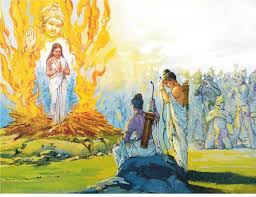I grew up thinking that Sita, the heroine of the Ramayana, was a slavish wife without a mind of her own who deserved the shabby treatment of her husband, Lord Ram. It took me a long time to understand that it is not Indian women’s masochism which makes Sita appear an appealing role model. It is her supreme loyalty, combined with her dignified refusal to go through the humiliation of a second fire ordeal. She makes Ram appear so uncouth and unreasonable that this one injustice has not been forgiven all these centuries.
During Ramanand Sagar’s “Ramayan” telecast on TV, as the episode approached when Sita’s fidelity was to be tested with an agnipariksha (fire ordeal), the serial makers were flooded in advance with so many letters protesting the depiction of Sita going through the agnipariksha that he had to deviate from his text and show a mock agnipariksha, with the TV Ram making it clear that he did not doubt Sita’s chastity. Clearly, Ram’s injustice to Sita hung so heavily on the collective conscience of Indians that they willingly demanded even a sacred text be altered.
I witnessed the power of Sita’s story to move men’s hearts in Maharashtra. I was working on the Lakshmi Mukti program to persuade peasants of the organization, Shetkari Sangathana, to empower women by voluntarily transferring a portion of the family land in the name of the wife. During our campaign, Sangathana leader Sharad Joshi pointed out to men how their wives toil for them selflessly, how crucial their wives’ labor and care is for the well-being of the family. He would ask his audience: “But how do we men treat our Lakshmi’s? [Sita is an incarnation of Lakshmi]. Often no better than Ram treated Sita! When Ram was banished for 14 years Sita could have stayed back, but she insisted, ‘Wherever goes Ram, there goes Sita. My place is by your side.’ She suffered numerous privations for him joyfully. Though Ram’s enemy, Ravan, respected her chastity when she was captured by him and did not violate Sita against her wishes, her own husband subjected her to the cruel humiliation of agnipariksha to prove her chastity. Even fire could not touch her. But on their return to his kingdom, at the mere hint of a slanderous remark by a laundryman, Ram asks Lakshman to take away Sita and leave her in a forest without explanation. Maharani (Great Queen) Sita became a beggar overnight because her husband turned against her. It did not occur to him to tell his subjects, ‘If Sita is not good enough to be your queen, then my place is by her side. I cannot stay here either.’ He left her destitute even while she was pregnant with his children.”
Joshi told his audience that the purpose of the Lakshmi Mukti program was to see that no modern-day Sita would ever have to suffer the fate of Ram’s Sita, left without anything to call her own. By transferring land to their wives, they were paying off “a long-overdue debt.” In village after village, I would see men reduced to tears listening to Sita’s story. In 15 months more than 613 villages carried out the Lakshmi Mukti program of land transfer to wives celebrating the occasion as though it were a festival. Men felt good atoning for the wrongdoing of Ram. An additional two thousand villages volunteered to accept the Lakshmi Mukti Program, but the leadership somehow lost momentum.
People will say approvingly, “He is a Ram-like son or a Ram-like brother or a Ram-like king,” but almost never say in approval, “He is a Ram-like husband.” Women do not wish a Ram-like husband, even while they wish to be as loyal as Sita. Likewise, no woman wants a Krishna or a Vishnu, for Krishna is seen as a Casanova who kept many women dangling after him. Women often pray for a Krishna-like child but almost never pray that they get a Krishna type husband.
Siva alone of all the Gods is considered the most desirable type of husband. Unmarried women fast on Mondays praying to Siva that He bless them with Parvati’s good fortune. Why? Because Siva is single-minded in his devotion to Parvati. He has no eye for any other woman. When she immolates herself as Sati to protest her father’s insult of her husband, Siva is ready to burn down the whole world and rests only after he has brought her back to life. She carries tremendous influence in his activities, a companion and advisor rather than a servile wife. They are our mythology’s most celebrated and happy couple, representing perfect joy in togetherness, including in their sexual union. Yet, Parvati had not been able to seduce him with her physical charm. She did rigorous austerities to win him.
Why do women want a Siva-like husband and not a Krishna or Ram? At the heart of this choice is the awareness that women’s well-being requires a stable family and a man who will act responsibly towards his wife and his children. Most women shudder at the prospect of being a single parent, like Sita. Nor do they want to be a wife like Rukmini, who is forever waiting for her husband, who is too busy with his various dalliances. For stable family life, sexual loyalty and restraint are pre-condition. Even while preaching its virtue to women, most men have found it hard to live by those norms. And women have had a hard time trying to hold men to it by making their own lives examples to be emulated in this respect. Some succeed partially, some well, some not at all. But most keep trying because they know if they give up or take to the ways of men, there is little possibility of finding an emotionally stable family life for themselves and their children.






